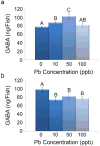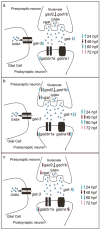Novel dose-dependent alterations in excitatory GABA during embryonic development associated with lead (Pb) neurotoxicity
- PMID: 24875535
- PMCID: PMC4109047
- DOI: 10.1016/j.toxlet.2014.05.016
Novel dose-dependent alterations in excitatory GABA during embryonic development associated with lead (Pb) neurotoxicity
Abstract
Lead (Pb) is a heavy metal that is toxic to numerous physiological processes. Its use in industrial applications is widespread and results in an increased risk of human environmental exposure. The central nervous system (CNS) is most sensitive to Pb exposure during early development due to rapid cell proliferation and migration, axonal growth, and synaptogenesis. One of the key components of CNS development is the Gamma-aminobutyric acid (GABA)-ergic system. GABA is the primary inhibitory neurotransmitter in the adult brain. However, during development GABA acts as an excitatory neurotrophic factor which contributes to these cellular processes. Multiple studies report effects of Pb on GABA in the mature brain; however, little is known regarding the adverse effects of Pb exposure on the GABAergic system during embryonic development. To characterize the effects of Pb on the GABAergic system during development, zebrafish embryos were exposed to 10, 50, or 100 ppb Pb or a control treatment. Tissue up-take, gross morphological alterations, gene expression, and neurotransmitter levels were analyzed. Analysis revealed that alterations in gene expression throughout the GABAergic system and GABA levels were dose and developmental time point specific. These data provide a framework for further analysis of the effects of Pb on the GABAergic system during the excitatory phase and as GABA transitions to an inhibitory neurotransmitter during development.
Keywords: Developmental toxicity; GABA; Gene expression; Lead; Neurotoxicity; Zebrafish.
Copyright © 2014 Elsevier Ireland Ltd. All rights reserved.
Conflict of interest statement
Figures




Similar articles
-
Decreased axonal density and altered expression profiles of axonal guidance genes underlying lead (Pb) neurodevelopmental toxicity at early embryonic stages in the zebrafish.Neurotoxicol Teratol. 2011 Nov-Dec;33(6):715-20. doi: 10.1016/j.ntt.2011.07.010. Epub 2011 Aug 4. Neurotoxicol Teratol. 2011. PMID: 21839828 Free PMC article.
-
Distribution of GABA-immunolabeling in the early zebrafish (Danio rerio) brain.Eur J Morphol. 1999 Apr;37(2-3):126-9. doi: 10.1076/ejom.37.2.126.4748. Eur J Morphol. 1999. PMID: 10342443
-
Persistent Metabolic Changes Are Induced by 24 h Low-Dose Lead (Pb) Exposure in Zebrafish Embryos.Int J Mol Sci. 2025 Jan 26;26(3):1050. doi: 10.3390/ijms26031050. Int J Mol Sci. 2025. PMID: 39940818 Free PMC article.
-
Basic developmental rules and their implications for epilepsy in the immature brain.Epileptic Disord. 2006 Jun;8(2):91-102. Epileptic Disord. 2006. PMID: 16793570 Review.
-
GABAergic signaling in the developing cerebellum.Anat Sci Int. 2004 Sep;79(3):124-36. doi: 10.1111/j.1447-073x.2004.00081.x. Anat Sci Int. 2004. PMID: 15453613 Review.
Cited by
-
Defining potential roles of Pb(2+) in neurotoxicity from a calciomics approach.Metallomics. 2016 Jun 1;8(6):563-78. doi: 10.1039/c6mt00038j. Metallomics. 2016. PMID: 27108875 Free PMC article. Review.
-
Intraventricular infusion of quinolinic acid impairs spatial learning and memory in young rats: a novel mechanism of lead-induced neurotoxicity.J Neuroinflammation. 2018 Sep 14;15(1):263. doi: 10.1186/s12974-018-1306-2. J Neuroinflammation. 2018. PMID: 30217162 Free PMC article.
-
The role of probiotic intervention in regulating gut microbiota, short-chain fatty acids and depression-like behavior in lead-exposed rats.Int J Occup Med Environ Health. 2022 Feb 15;35(1):95-106. doi: 10.13075/ijomeh.1896.01795. Epub 2022 Feb 10. Int J Occup Med Environ Health. 2022. PMID: 35143471 Free PMC article.
-
Embryonic ionizing radiation exposure results in expression alterations of genes associated with cardiovascular and neurological development, function, and disease and modified cardiovascular function in zebrafish.Front Genet. 2014 Aug 7;5:268. doi: 10.3389/fgene.2014.00268. eCollection 2014. Front Genet. 2014. PMID: 25147559 Free PMC article.
-
The neurological toxicity of heavy metals: A fish perspective.Comp Biochem Physiol C Toxicol Pharmacol. 2018 Jun;208:12-19. doi: 10.1016/j.cbpc.2017.11.008. Epub 2017 Dec 1. Comp Biochem Physiol C Toxicol Pharmacol. 2018. PMID: 29199130 Free PMC article. Review.
References
-
- Bae YK, Kani S, Shimizu T, Tanabe K, Nojima H, Kimura Y, Higashijima S, Hibi M. Anatomy of zebrafish cerebellum and screen for mutations affecting its development. Develop biol. 2009;330:406–426. - PubMed
-
- Centers for Disease Control and Prevention. Lead Home Page. Atlanta: CDC.gov;
-
- Chen J, Chen Y, Liu W, Bai C, Liu X, Liu K, Li R, Zhu JH, Huang C. Developmental lead acetate exposure induces embryonic toxicity and memory deficit in adult zebrafish. Neurotoxicol Teratol. 2012;34:581–586. - PubMed
Publication types
MeSH terms
Substances
Grants and funding
LinkOut - more resources
Full Text Sources
Other Literature Sources

